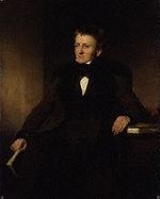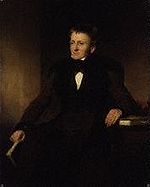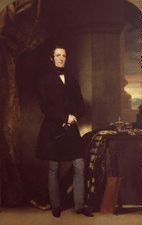
John Watson Gordon
Encyclopedia

Scotland
Scotland is a country that is part of the United Kingdom. Occupying the northern third of the island of Great Britain, it shares a border with England to the south and is bounded by the North Sea to the east, the Atlantic Ocean to the north and west, and the North Channel and Irish Sea to the...
portrait painter
Portrait painting
Portrait painting is a genre in painting, where the intent is to depict the visual appearance of the subject. Beside human beings, animals, pets and even inanimate objects can be chosen as the subject for a portrait...
and a president of the Royal Scottish Academy
Royal Scottish Academy
The Royal Scottish Academy is a Scottish organisation that promotes contemporary Scottish art. Founded in 1826, as the Royal Institution for the Encouragement of the Fine Arts, the RSA maintains a unique position in Scotland as an independently funded institution led by eminent artists and...
.
Life and work
He was born John Watson in EdinburghEdinburgh
Edinburgh is the capital city of Scotland, the second largest city in Scotland, and the eighth most populous in the United Kingdom. The City of Edinburgh Council governs one of Scotland's 32 local government council areas. The council area includes urban Edinburgh and a rural area...
, the eldest son of Captain Watson, R.N., a cadet of the family of Watson of Overmains, in the county of Berwick. He was educated specially with a view to joining the Royal Engineers
Royal Engineers
The Corps of Royal Engineers, usually just called the Royal Engineers , and commonly known as the Sappers, is one of the corps of the British Army....
. He entered as a student in the government school of design, under the management of the Board of Manufactures. he showed a natural aptitude for art, and his father was persuaded to allow him to adopt it as his profession. Captain Watson was himself a skilful draughtsman, and his brother George Watson
George Watson (painter)
George Watson was a Scottish portrait painter and first president of the Royal Scottish Academy.-Life and work:Watson was born at his father's estate, Overmains, Berwickshire, in 1767, the son of John Watson and Frances Veitch of Elliott...
, afterwards president of the Royal Scottish Academy, was a highly-respected portrait painter, second only to Sir Henry Raeburn
Henry Raeburn
Sir Henry Raeburn was a Scottish portrait painter, the first significant Scottish portraitist since the Act of Union 1707 to remain based in Scotland.-Biography:...
, who was also a friend of the family.
In 1808 John exhibited a picture "The Lay of the Last Minstrel
The Lay of the Last Minstrel
"The Lay of the Last Minstrel" is a long narrative poem by Walter Scott. -Overview:...
" at the Lyceum in Nicolson Street, Edinburgh - the first public exhibition of paintings in that city - and continued for some years to exhibit fancy subjects; but, although freely and sweetly painted, they were altogether without the force and character which stamped his portrait pictures as the works of a master. After the death of Sir Henry Raeburn in 1823, he succeeded to much of his practice. He assumed in 1826 the name of Gordon.

John Gibson Lockhart
John Gibson Lockhart , was a Scottish writer and editor. He is best known as the author of the definitive "Life" of Sir Walter Scott...
in 1821; Professor Wilson, 1822 and 1850, two portraits; Sir Archibald Alison, 1839; Dr Chalmers
Thomas Chalmers
Thomas Chalmers , Scottish mathematician, political economist, divine and a leader of the Free Church of Scotland, was born at Anstruther in Fife.-Overview:...
, 1844; a little later De Quincey
Thomas de Quincey
Thomas Penson de Quincey was an English esssayist, best known for his Confessions of an English Opium-Eater .-Child and student:...
, and Sir David Brewster
David Brewster
Sir David Brewster KH PRSE FRS FSA FSSA MICE was a Scottish physicist, mathematician, astronomer, inventor, writer and university principal.-Early life:...
, 1864. Among his most important works may be mentioned the 1st Marquess of Dalhousie; Sir Alexander Hope (1835); Lord President Hope; and Dr Chalmers. These, unlike his later works, are generally rich in colour. The full length of Dr Brunton (1844), and Dr Lee
John Lee (University Principal)
John Lee was a British academic and polymath and was the principal of the University of Edinburgh from 1840 to 1859. He was also a Moderator of the General Assembly of the Church of Scotland....
, the principal of the university (1846), mark a modification of his style, which ultimately resolved itself into extreme simplicity, both of colour and treatment.
During the last twenty years of his life he painted many distinguished Englishmen who came to Edinburgh to sit to him. And it is significant that David Cox
David Cox (artist)
- David Cox Junior :David Cox had a son of the same name who followed his calling as a watercolour painter. He was born in Dulwich, but educated in Hereford. He exhibited in London from 1827, although today he is known mainly through association with his father. He died in Streatham on 4 December...
, the landscape painter, on being presented with his portrait, subscribed for by many friends, chose to go to Edinburgh to have it executed by Watson Gordon, although he neither knew the painter personally nor had ever before visited the country. Among the portraits painted during this period, in what may be termed his third style, are De Quincey; General Sir Thomas Macdougall Brisbane
Thomas Brisbane
Major-General Sir Thomas Makdougall Brisbane, 1st Baronet GCH, GCB, FRS, FRSE was a British soldier, colonial Governor and astronomer.-Early life:...
; the Prince of Wales, Lord Macaulay, Sir M. Packington, Lord Murray
John Murray, Lord Murray
Sir John Archibald Murray, Lord Murray, was a Scottish judge.Son of Alexander Murray, Lord Henderland, he contributed to the Edinburgh Review from its commencement. He was a promoter of the 1832 Reform Bill and was Member of Parliament for Leith Burghs from 1832 until 1839.He was appointed Lord...
, Lord Cockburn, Lord Rutherford and Sir John Shaw-Lefevre.
These latter pictures are mostly clear and grey, sometimes showing little or no positive colour, the flesh itself being very grey, and the handling extremely masterly, though never obtruding its cleverness. He was very successful in rendering acute observant character. A good example of his last style, showing pearly flesh-painting freely handled, yet highly finished, is his head of Sir John Shaw-Lefevre.
Gordon was one of the earlier members of the Royal Scottish Academy, and was elected' its president in 1850; he was at the same time appointed limner for Scotland to the queen
Painter and Limner
The Painter and Limner is a member of the Royal Household in Scotland. Appointments of Court Painters are recorded from 1581 onwards, and the post of Painter and Limner was created in 1702 for George Ogilvie. The duties included "drawing pictures of our [the Monarch's] person or of our successors...
, and received the honour of knighthood. Since 1841 he had been an associate of the Royal Academy, and in 1851 he was elected a royal academician.
External links
- Sir John Watson-Gordon ( The Walter Scott Digital Archive)
- Works in the National Galleries of Scotland
- John Watson Gordononline (Artcyclopedia)

